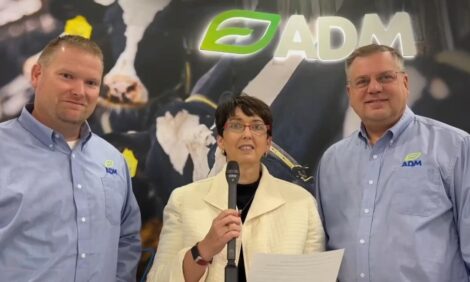



How to Make Group Calf Housing Work For You
Group housing of calves is growing in popularity across US dairies, meaning a switch is made from individual hutches.One feature of group housing is flexibility of calf feeding, writes a student at Virginia Tech University Extension.
There are several feeding system options for this type of calf rearing. Generally, labour efficiency is increased in terms of milk volume fed per hour of labour.
Alyssa Dietrich, a master's student at the University, writes that this means systems make it easy to feed larger volumes of milk without increasing labour requirements significantly.
Mob feeding is one option that consists of using a large container with multiple nipples to deliver liquid feed to a group of calves at one time.
Feeding acidified milk ad libitum is another system in which acid is added to milk to preserve it so that milk can be stored in a tank while calves access it throughout the day.
Computer controlled automatic calf feeders are another alternative that allow for more control over individual calf intake, meal frequency, and monitoring. Automatic feeders recognize individual calves and feed them precise amounts of liquid feed determined by a feeding plan controlled by the producer.
Housing calves in groups also allows for expression of natural social behaviours. These systems encourage calves to play with and learn from each other.
Social interactions may help calves cope with stressful events. Several research studies have shown that calves housed in groups or pairs are less stressed during handling and relocating events compared to individually housed calves.
It has also been found that calves housed in groups or pairs are quicker to consume feed after weaning, indicating that they are more able to cope with the removal of liquid feed.
Despite the benefits of group housing,there are risks associated with this system of calf rearing. Disease transfer between calves is a concern for two main reasons: calf to calf contact and improperly designed ventilation.

While poorly ventilated housing increases disease risk to any calves housed indoors, the nose to nose contact between group housed calves allows them to transfer disease easily. Furthermore, it may be more difficult for employees to monitor individual calf health, since they are not being fed individually. Regardless, group housing systems can achieve success with proper management practices. First, new calves entering a group pen must be healthy.
Success starts at the freshening pen, which needs to be clean and well-bedded. Colostrum management is obviously important for calf health in any rearing system but is especially critical in group housing systems, due to the aforementioned risks.
Colostrum should be collected into and fed with clean equipment, and colostrum quality should be monitored. In the calf barn, adequate ventilation is critical in preventing respiratory disease. The ventilation system must include the introduction of fresh outside air and prevention of “dead spots” in the facility where viral or bacterial pathogens can accumulate.
Obtaining professional assistance to design and implement these systems is a wise investment. Facility cleanliness must also be maintained to ensure group housing success.
Clean milk feeding equipment, waterers, grain troughs, and bedding are essential in keeping calves healthy. When possible, the “all-in, all-out” method should be utilized and pens should be sanitized between groups of calves. Space allotment is also important for ensuring calf success.
Calves should have access to at least 30 ft2 of bedded area to allow for plenty of rest. Finally, group-housed calves need to be monitored closely to detect and respond to illness in a timely manner. The time you save with more efficient feeding should be focused on managing your facilities and observing your calves diligently.


